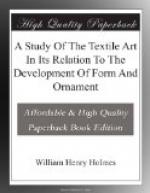A large class of embroideries are applied by like processes, but without reference to the construction of the foundation fabric, as they are also applied to felt and leather. Again, artificially prepared perforations are used, through which the fillets are passed. The results are much less uniformly geometric than where the fabric is followed; yet the mere adding of the figures, stitch by stitch or part by part, is sufficient to impart a large share of geometricity, as may be seen in the buckskin bead work and in the dentalium and quill work of the Indians.
Feather embroidery was carried to a high degree of perfection by our ancient aborigines, and the results were perhaps the most brilliant of all these wonderful decorations. I have already shown how feathers are woven in with the warp and woof, and may now give a single illustration of the application of feather work to the surfaces of fabrics. Among the beautiful articles recovered from the tombs of Ancon, Peru, are some much decayed specimens of feather work. In our example delicate feathers of red, blue, and yellow hues are applied to the surface of a coarse cotton fabric by first carefully tying them together in rows at regular distances and afterwards stitching them down, as shown in Fig. 337.
The same method is practiced by modern peoples in many parts of the world. Other decorative materials are applied in similar ways by attachment to cords or fillets which are afterwards stitched down. In all this work the geometricity is entirely or nearly uniform with that of the foundation fabrics. Other classes of decoration, drawn work, applique, and the like, are not of great importance in aboriginal art and need no additional attention here, as they have but slight bearing upon the development of design.
[Illustration: FIG. 337. Feather embroidery of the ancient Peruvians, showing the method of attaching the feathers.]
Attached or appended ornaments constitute a most important part of decorative resource. They are less subject to the laws of geometricity, being fixed to surfaces and margins without close reference to the web and woof. They include fringes, tassels, and the multitude of appendable objects, natural and artificial, with which primitive races bedeck their garments and utensils. A somewhat detailed study of this class of ornament is given at the end of the preceding section.
Adventitious features.—Ornament is applied to the surfaces of fabrics by painting and by stamping. These methods of decoration were employed in very early times and probably originated in other branches of art. If the surface features of the textile upon which a design is painted are strongly pronounced, the figures produced with the brush or pencil will tend to follow them, giving a decidedly geometric result. If the surface is smooth the hand is free to follow its natural tendencies, and the results will be analogous in character to




